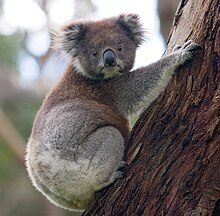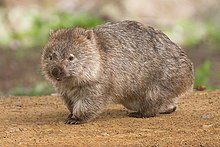Vombatiformes
| Vombatiformes Temporal range:
| |
|---|---|

| |
| Phascolarctos cinereus | |
| Scientific classification | |
| Kingdom: | Animalia |
| Phylum: | Chordata |
| Class: | Mammalia |
| Infraclass: | Marsupialia |
| Order: | Diprotodontia |
| Suborder: | Vombatiformes Burnett, 1830 |
| Families | |
| |
The Vombatiformes are one of the three suborders of the large marsupial order Diprotodontia. Seven of the nine known families within this suborder are extinct; only the families Phascolarctidae, with the koala, and Vombatidae, with three extant species of wombat, survive.
Among the extinct families are the Diprotodontidae, which includes Diprotodon, believed by many to be the inspiration for the bunyip. "Vombatiformes" is neo-Latin for "wombat-shaped things", and took its name from its type family.
The suborder Vombatiformes, with its closely related members and their compact body form, contrasts with the other two diprotodont suborders, the Macropodiformes: kangaroos, wallabies, and the quokka; and the Phalangeriformes: possums, including the gliders such as the wrist-winged gliders. The koala and wombats are believed by many biologists to share a common ancestor and to have diverged only recently in the Cenozoic.
In June 2020, , within its own family , was declared by scientists after studying fossils originally discovered in Lake Eyre in 1973, and rediscovered in a drawer in the American Natural History Museum in New York around 2010. The study revealed that the fossil represented the closest fossil relative of the wombat family, meaning that they all evolved from a common ancestor. Mukupirna means "big bones" in the Diyari and Malyangapa languages of the area where it was found.[1][2][3]
Classification[]

Suborder Vombatiformes
- Family Vombatidae: wombats (three modern species)
- Genus †Rhizophascolonus
- Genus Vombatus
- Genus †Phascolonus
- Genus †Warendja
- Genus †Ramasayia
- Genus Lasiorhinus
- Family Phascolarctidae: koala (one modern species)[4]
- Genus †Perikoala
- Genus †Madakoala
- Genus †Koobor
- Genus †Litokoala
- Genus †Nimiokoala
- Genus Phascolarctos
- Family †Ilariidae
- genus †Nimbadon
- Genus †
- Genus †Kuterintja
- Genus †Ilaria
- Family †Maradidae
- Family †[1][2]
- Genus †
- Family †Thylacoleonidae: (marsupial lions)[6]
- Genus †Thylacoleo
- Genus †Priscileo
- Genus †Wakaleo
- Family †Wynyardiidae
- Genus †
- Genus †Muramura
- Genus †Namilamadeta
- Superfamily Diprotodontoidea[7]
- Family †Diprotodontidae: (giant wombats)[7]
- Genus †Alkwertatherium
- Genus †Bematherium
- Genus †Pyramios
- Genus †Nototherium
- Genus †Meniscolophus
- Genus †Euryzygoma
- Genus †Diprotodon
 †Diprotodon optatum
†Diprotodon optatum - Genus †Euowenia
- Genus †Sthenomerus
- Subfamily †Zygomaturinae[7]
- Genus †Silvabestius
- Genus †Neohelos[7]
- Genus †Raemeotherium
- Genus †Plaisiodon
- Genus †Zygomaturus
- Genus †Kolopsis[7]
- Genus †Kolopsoides
- Genus †Hulitherium
- Genus †Maokopia
 †Palorchestes azael
†Palorchestes azael
- Family †Palorchestidae: (marsupial tapirs)[7]
- Genus †Palorchestes
- Genus †Propalorchestes
- Genus †Ngapakaldia
- Genus †
- Family †Diprotodontidae: (giant wombats)[7]
References[]
| Wikimedia Commons has media related to Vombatiformes. |
| Wikispecies has information related to Vombatiformes. |
- Groves, C. P. (2005). Wilson, D. E.; Reeder, D. M. (eds.). Mammal Species of the World: A Taxonomic and Geographic Reference (3rd ed.). Baltimore: Johns Hopkins University Press. pp. 43–44. ISBN 0-801-88221-4. OCLC 62265494.
- ^ a b Salleh, Anna (25 June 2020). "Fossil of modern wombats' giant extinct cousin found in US museum, 50 years after initial discovery". ABC News (ABC Science). Australian Broadcasting Corporation. Retrieved 30 June 2020.
- ^ a b Davis, Nicola; Zhou, Naaman (25 June 2020). "Fossils of 'big boned' marsupial shed light on wombat evolution". The Guardian. Retrieved 25 June 2020.
- ^ Beck, Robin M. D.; Louys, Julien; et al. (25 June 2020). "A new family of diprotodontian marsupials from the latest Oligocene of Australia and the evolution of wombats, koalas, and their relatives (Vombatiformes)". Scientific Reports. 10 (9741). doi:10.1038/s41598-020-66425-8. PMID 32587406. Retrieved 30 June 2020 – via Nature.
- ^
McKenna, Malcolm C.; Bell, Susan K., eds. (1997). Classification of mammals – above the species level. New York: Columbia University Press. pp. xii–631. ISBN 9780231110129.
{{cite book}}:|first2=has generic name (help) - ^ BLACK, K., March 2007. Maradidae: a new family of vombatomorphian marsupial from the late Oligocene of Riversleigh, northwestern Queensland. Alcheringa 31, 17-32. ISSN 0311-5518
- ^ Naish, Darren. "Of koalas and marsupial lions: the vombatiform radiation, part I". Scientific American. Scientific American, Inc. Retrieved 24 October 2015.
- ^ a b c d e f Black, K. (2012). "Revision in the marsupial diprotodontid genus Neohelos: Systematics and biostratigraphy". Acta Palaeontologica Polonica. doi:10.4202/app.2012.0001.
- Vombatiforms
- Chattian first appearances



